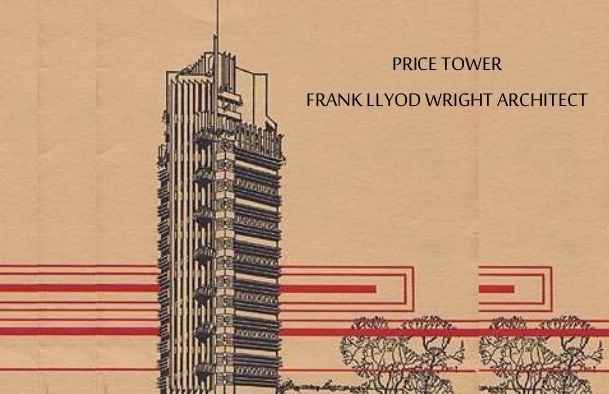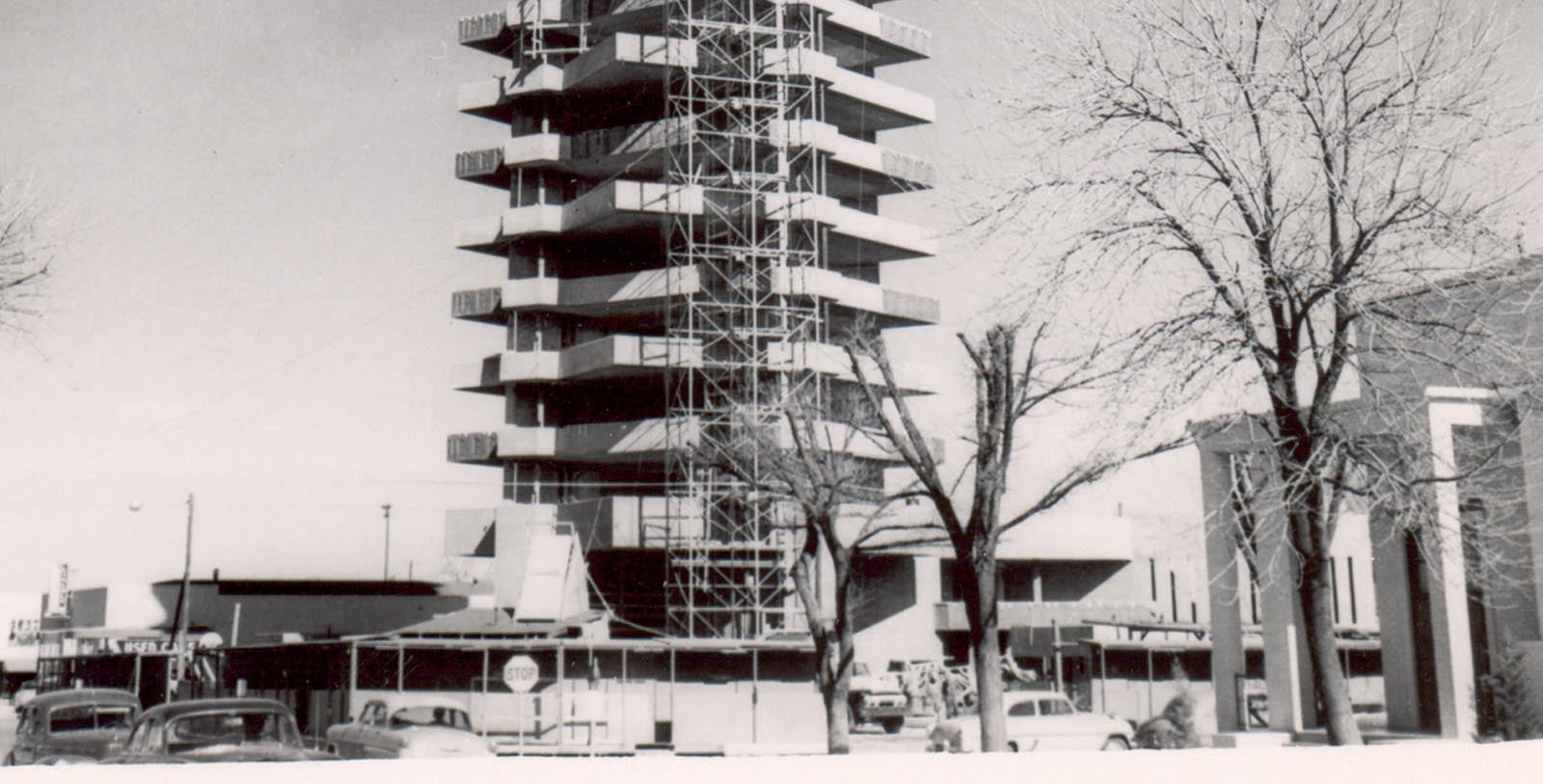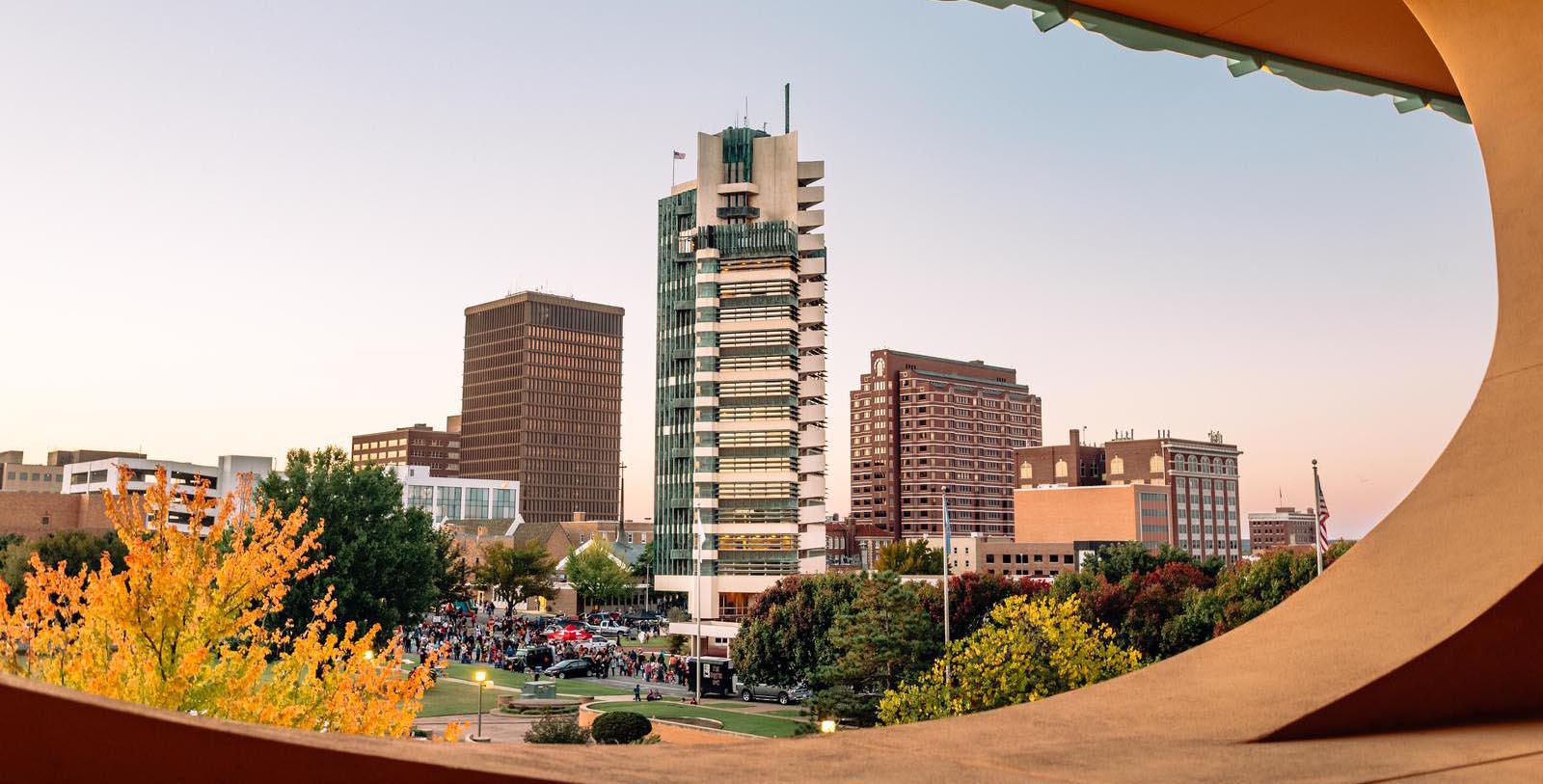Receive for Free - Discover & Explore eNewsletter monthly with advance notice of special offers, packages, and insider savings from 10% - 30% off Best Available Rates at selected hotels.
history
Discover the Inn at Price Tower with its unique Frank Lloyd Wright design.
Inn at Price Tower, a member of Historic Hotels of America since 2014, dates back to 1956.
VIEW TIMELINE
Photojournal: Price Tower
The Price Tower is one of 10 Frank Lloyd Wright structures nominated by the United States to be included on the World Heritage List. In this video created by The Oklahoma News Report, photographer Tony D’Astoli gives a behind the scenes tour of the tower.
WATCH NOWOne of Oklahoma’s most iconic luxury hotels, the Inn at Price Tower has been a member of Historic Hotels of America since 2014. But this fantastic historic destination is just one of several facilities that reside within the famous Price Tower, which has stood as a cherished local landmark in downtown Bartlesville for more than half a century. In 1952, Harold C. Price – the founder of the H.C. Price Company – began contemplating the construction of a new headquarters in downtown Bartlesville. Price desired such a move, since the community was close to the oil and natural gas reservoirs that relied upon his company’s pipelines. He selected a lot along Sixth Street and Dewey Avenue for the site of his new building. At the behest of a family friend, architect Bruce Goff of the University of Oklahoma, Price hired the renowned Frank Lloyd Wright to head the project design team. After discussing plans with the architect in Washington, Wright successfully convinced the Prices to erect a massive skyscraper that featured a blend of offices and luxury apartments. The partnership would eventually blossom into a lifelong friendship between Wright and the Prices, with the former designing a number of private residences for the Price family.
Over the course of the next four years, Wright and his contractor, Haskell Culwell, diligently constructed Price’s new headquarters. Wright specifically approached its design in a rather peculiar manner, envisioning its skeleton to resemble the physiology of a tree. In fact, he even considered the new building to be “the tree that escaped the crowded forest” of America’s 20th-century urban sprawl. Wright supported the entire building upon a central “trunk” of four elevator shafts, which were anchored by a solid foundation that Wright compared to a matured tree’s root system. Nineteen stories proliferated from the base, cantilevered in a style that he thought looked like the branches of an in-bloom canopy. Wright’s team even hung the outer walls from the various floors as if leaves were being draped from the building’s interior. But the architect also devoted considerable attention to the building’s interiors, in which he incorporated several unique architectural finishes. Among the most unique design features that Wright installed were solid-gold wall paintings and beautiful aluminum-trimmed windows. He even inscribed two inscriptions from Walt Whitman’s “Salut au Monde” and the “Song of the Broad-Axe” inside the structure’s gorgeous lobby, as well.
When “Price Tower” finally debuted in early 1956, it was truly a site to behold. The H.C. Price Company quickly moved into the structure, where it would remain until the end of the century. Nevertheless, the Phillips Petroleum Company would purchase the rights to Price Tower in 1981, when the H.C. Price Company eventually relocated to Dallas, Texas. It subsequently made space available inside the building for the Bartlesville Museum for a while, before becoming the “Price Tower Arts Center” a decade later in 1998. The organization was then joined by the Inn at Price Tower and restaurant called “Cooper” in the early 2000s, after Price Tower had started to emerge as a popular national tourist attraction due to its rich connection to Frank Llyod Wright. Price Tower itself has since become an iconic historical landmark in both the United States and abroad, as such. For instance, the U.S. Department of the Interior listed it as a U.S. National Historic Landmark in 2007. Then in 2019, the United Nations declared the whole building to be one of its prestigious UNESCO World Heritage Sites, thanks to the efforts of the U.S. National Park Service to share Wright’s work on an international scale. Needless to say, cultural heritage travelers would certainly find the historic Inn at Price Tower to be an incredibly fascinating destination to experience.
-
About the Location +
Bartlesville can trace its heritage back to Jacob Bartles, the son-in-law of a Native American chief named Charles Journeycake. In 1873, Bartles moved his family from Kansas to the shoreline of Silver Lake in Oklahoma, then known as “Indian Territory.” (Oklahoma would not become a state until 1912.) Within a year, Bartles established a rustic trading post in a village he called “Turkey Creek,” which gradually expanded to include a general store, blacksmith shop, livery, a rooming house. Furthermore, Bartles operated a rudimentary grist mill that specialized in producing flour for his other businesses. (The grist mill was actually constructed by the area’s first non-Indian resident, Nelson F. Carr, in 1870. Carr himself had married into a Cherokee family, allowing him access to Indian Territory land.) Soon enough, other settlers began migrating to the settlement, who quickly called the community “Bartles Town.” Its population grew gradually, incentivizing Bartles to provide municipal amenities like electricity, plumbing, and even a telephone network. The town subsequently flourished for a while, as many new businesses debuted in rapid succession in just a matter of months. Perhaps the greatest industrial operations to affect the nascent community at the time was the arrival of the Atchison, Topeka, and Santa Fe Railway. By the late 1890s, Bartlesville had grown large enough that it was formally incorporated as “Bartlesville,” with Thomas A. Stewart serving as the first mayor.
Bartlesville’s true golden years occurred when prospectors began drilling oil in the surrounding fields. While the presence of oil had been known to inhabit the area as far back as 1875, most people avoided collecting it due to the lack of any modern infrastructure. Everything changed, though, after the railroads started running trains frequently through Bartlesville. Encouraged by the access to a rail system, two local businessmen, George B. Keeler and William Johnstone, began looking for a massive reservoir of oil out by the Caney River. They subsequently financed the development of Oklahoma’s first commercial oil derrick in 1897, which they christened as the “Nellie Johnstone No. 1.” Keeler and Johnstone’s surveyal of the region proved to be wise, as the well immediately struck oil. Word quickly spread of Nellie Johnstone No. 1’s success, attracting dozens of additional entrepreneurs from across the country. Among the most noteworthy oil tycoons to setup their own derricks in the area included Harry F. Sinclair, J. Paul Getty, and Frank Phillips, whose house in downtown Bartlesville serves as a historic site today. More than 60 different oil company’s were soon headquartered in Bartlesville, such as the Barnsdall Oil Company, the Indian Territory Illuminating Oil Company, and the historic Phillips Petroleum Company. The vibrant oil industry also attracted many other kinds of businesspeople that were eager to service the industry in any way imaginable. Harold C. Price was one such individual, who aided in the construction of local oil pipelines though his own business, the H.C. Price Company.
Bartlesville remained one of Oklahoma’s most economically vibrant communities well into the latter stages of the 20th-century. Many new economic endeavors manifested throughout the century, including natural gas-fired smelters, oil-pump factories, and pipeline manufacturers. Bartlesville nevertheless remained one of the epicenters for America’s oil industry, with the Phillips Petroleum Company—the future ConocoPhillips—acting as the town’s main employer. The local population subsequently exploded, rising from a mere 4,000 in 1907 to nearly 20,000 in 1950. But despite its continued emphasis on heavy industry, Bartlesville has also emerged as one of Oklahoma’s most exciting holiday destinations, too. Cultural heritage travelers enjoy the historical structures that call the community home, many of which are listed on the U.S. National Register of Historic Places. Some of those structures include the Old Washington Court House, the Frank Phillips House, and the iconic Price Tower. Much of downtown Bartlesville is currently preserved as the federally protected “Bartlesville Downtown Historic District," too. Other fascinating cultural attractions within Bartlesville include the Price Tower Arts Center, the Phillips Petroleum Company Museum, and the Bartlesville Area History Museum. Bartlesville is even close to a few other fascinating destinations just beyond its borders, including the picturesque Woolaroc Museum & Wildlife Preserve.
-
About the Architecture +
The Inn at Price Tower resides within the iconic Price Tower, the only skyscraper that Frank Llyod Wright ever created. Wright specifically approached its design in a rather peculiar manner, envisioning its skeleton to resemble the physiology of a tree. In fact, he even considered the new building to be, “the tree that escaped the crowded forest,” of America’s 20th-century urban sprawl. Wright supported the entire building upon a central “trunk” of four elevator shafts, which were anchored by a solid foundation that he compared to a matured tree’s root system. Nineteen stories proliferated out from the base, cantilevered in a style that Wright thought looked like the branches of an in-bloom canopy. Wright’s team even hung the outer walls from the various floors as if leaves were being draped from the building’s interior. His approach to designing Price Tower was actually born out of an earlier structure that he had tried to build in Manhattan during the 1920s—St. Marks-in-the-Bowerie. Originally intended to serve as an upscale apartment complex, the entire project was cancelled after the Great Depression befell the country the following decade. Wright, thus, saw a great opportunity to revive the design when the Price family approached him about designing a unique skyscraper out in Oklahoma in 1952. But the building’s interior spaces feature a number of unique architectural finishes, too. Among the most unique design features that he installed were solid-gold wall paintings and beautiful aluminum-trimmed windows. He even inscribed two inscriptions from Walt Whitman’s “Salut au Monde” and the “Song of the Broad-Axe” inside the structure’s gorgeous lobby, as well.
Architects today consider the Price Tower itself to stand as a fascinating example of Mid-Century Modern architecture. An offshoot of the earlier International and Bauhaus movements, Mid-Century Modern itself sought to portray a seemingly contemporary, futuristic aesthetic that reflected the popular concepts of civil progress. Professional architects mainly utilized the style from the 1930s to the 1960s, when American society was rapidly undergoing huge transformations—both social and technological in nature. Architects thus embraced the design ideals of function, simplicity, and rationality in order to create sleek-looking structures that possessed a communal purpose. As such, Mid-Century Modern designs made explicit use of vertical, flat lines and irregular rectangular shapes that conveyed a lack of formality. Overt ornamentation was abandoned, too, as monochromatic brickwork, steel, and concreate served as the essential building blocks for the exterior. Inside, most of the rooms were subdivided into split levels, giving a sense that the structure had undergone a significant change in elevation. Modernist buildings also featured wide, open spaces filled with natural light that represented practicality and comfort. Large widows often functioned as the primary way in which the architects achieved such a feature. The introduction of spacious windows even sought to better incorporate nature into the design, making the surrounding landscape seem as if it were part of the building itself.
-
Art Collection +
In addition to dining, one can peruse the art gallery or exhibition on the first floor of the Price Tower Arts Center located next to the reception area. The gallery and exhibition calendar changes quarterly, so if guests plan to visit often, annual memberships are available and offer NARM benefits to museums across the country. On the 2nd floor, the Price Tower Arts Center is host to a permanent historical collection of Frank Lloyd Wright and the H.C. Price Company. For historical tourists and other guests who are intrigued by the unique architectural design of the building, guided public tours of the Price Tower (which include the historic 17th, 18th, and 19th floors) are available during regular business hours and by appointment for private tours. Tour reservations are encouraged and can be made with the receptionist at check in or anytime during a stay at the Inn at Price Tower. Visitors today can also access Architectural Study Center, a research library that provides access to rare documents and drawings by Frank Lloyd Wright, and his colleague, Bruce Goff.































